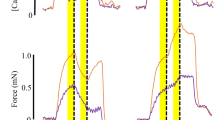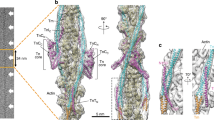Abstract
The mechanism of contraction in rabbit fast-twitch, and bovine and rabbit cardiac muscle was examined using functionally skinned fibers, ATPase activity of myofibrils, and cardiac or skeletal troponintropomyosin regulated actin heavy meromyosin. The Ca2+ and Sr2+ activation properties for the different measures of contraction were evaluated. (1) Tension in rabbit and bovine cardiac skinned fibers and rabbit cardiac myofibrillar ATPase were activated equally well by either Ca2+ or Sr2+. By contrast, rabbit adductor magnus (fast-twitch) skinned fibers required substantially higher [Sr2+] than [Ca2+] for activation, as did rabbit myofibrils from back muscle (fast-twitch). (2) Substantially more Sr2+ than Ca2+ was also required for activation of skeletal muscle actin heavy meromyosin ATPase, controlled by either the skeletal or cardiac troponin-tropomyosin complex, similar to the activation of fast-twitch muscle. (3) The absence of correlation between the divalent cation selectivity properties of actin heavy meromyosin ATPase controlled by cardiac troponin-tropomyosin and cardiac muscle tension or myofibrillar ATPase activation by Ca2+ and Sr2+ suggests that troponin, if primarily responsible for the activation of cardiac muscle, has very different in vivo and in vitro binding properties. (4) The close correlation between percentage of maximal Ca2+- and Sr2+-activated myofibrillar ATPase and tension in skinned fibers strongly justifies the use of myofibrillar ATPase, in contrast to a reconstituted troponin-tropomyosin actin heavy meromyosin ATPase system, as a biochemical measure of contraction.
Similar content being viewed by others
References
Alaba JO (1975) Muscle calcium binding proteins and regulation of carbohydrate metabolism. Ph. D. thesis, University of Washington, Seattle, Washington
Amphlett GW, Vanaman TC, Perry SV (1976) Effect of the troponin C-like protein from bovine brain (brain modulator protein) on the Mg2+-stimulated ATPase of skeletal muscle actomyosin. FEBS Lett 72:163–168
Berson G (1974) Ca2+, Sr2+ and Ba2+ sensitivity of tropomyosin-troponin complex from cardiac and fast skeletal muscles. In: Drabikowski W, Strzelecka-Golaszewska, H, Carafoli E (eds), Calcium binding proteins. Elsevier, Amsterdam New York Warsaw, pp. 197–201
Best PM, Donaldson SKB, Kerrick WGL (1977) Tension in mechanically disrupted mammalian cardiac cells. Effects of magnesium adenosine triphosphate. J Physiol (Lond) 265:1–17
Burtnick LD, McCubbin WD, Kay CM (1974) Molecular and biological studies on cardiac muscle Ca2+-binding protein (TNC). Can J Biochem 53:15–20
Cheung WY (1980) Calmodulin plays a pivotal role in cellular regulation. Science 207:19–27
Collins JH (1976) Homology of myosin DTNB light chain with alkali light chains, troponin C and parvalbumin. Nature 259: 699–700
Collins JH, Potter JD, Horn MJ, Wilshire G Jackman N (1973) The amino acid sequence of rabbit skeletal muscle troponin C: Gene replication and homology with calcium-binding proteins from carp and hake muscle. FEBS Lett 36:268–272
Donaldson SKB, Kerrick WGL (1975) Characterization of the effects of Mg2+ on Ca2+- and Sr2+-activated tension generation of skinned skeletal muscle fibers. J Gen Physiol 66:427–444
Drabikowski W, Barylko B, Dabrowska R, Nowak E, Szpacenko A (1974) Studies on the properties of TN-C component of troponin and on its effect on the interaction between the constituents of thin filament. In: Drabikowski W, Strzelecka-Golaszewska H, Carafoli E (eds), Calcium binding proteins. Elsevier, Amsterdam New York Warsaw, pp 69–107
Ebashi S, Endo M, Ohtsuki I (1969) Control of muscle contraction. Quart Rev Biophys 2:351–384
Ebashi S, Wakabashi P, Ebashi F (1971) Troponin and its components. J Biochem (Tokyo) 69:441–445
Ebashi S, Ohnishi S, Abe S, Maruyama K (1974) Ca-dependent interaction of troponin components as the basis of the control mechanism by Ca ion. In: Drabikowski W, Strzelecka-Golaszewska H, Carafoli E (eds), Calcium binding proteins. Elsevier, Amsterdam New York Warsaw, pp 179–196
Eggleton P, Elsden SR, Gough N (1943) The estimation of creatine and of diacetyl. Biochem J 37:526–529
Eisenberg E, Moos C (1967) The interaction of actin with myosin and heavy meromyosin in solution at low ionic strength. J Biol Chem 242:2945–2951
Eisenberg E, Kielley W, (1974) Troponin-tropomyosin complex. J Biol Chem 249:4742–4748
Fiske C, Subbarow Y (1925) The colorimetric determination of phosphorus. J Biol Chem 66:375–400
Fuchs F, (1974) Chemical properties of the calcium receptor site of troponin as determined from binding studies. In: Drabikowski W, Strzelecka-Golaszewska H, Carafoli E (eds), Calcium binding proteins. Elsevier, Amsterdam New York Warsaw, pp 1–27
Gergely J, (1977) Contractile proteins. In: Rowland LP (ed), Pathogenesis of human muscular dystrophies. Excerpta-Medica, Amsterdam Oxford, pp 351–358
Grand RJA, Wilkinson JM, Mole LE (1976) The amino acid sequence of rabbit cardiac troponin I. Biochem J 159:633–641
Greaser M, Gergely J (1973) Purification and properties of the components from troponin. J Biol Chem 248:2125–2133
Hartshorne D, Mueller H (1969) Preparation of tropomyosin and troponin from natural actomyosin. Biochem Biophys Acta 175:301–318
Haselgrove JC (1975) X-ray evidence for conformational changes in the myosin filaments of vertebrate striated muscle. J Mol Biol 92:113–143
Hellam DC, Podolsky RJ (1969) Force measurements in skinned muscle fibres. J Physiol (Lond) 200:807–819
Hoar PE, Kerrick WGL (1979) Rabbit diaphragm: Two types of fibres determined by calcium/strontium activation and protein content. J Physiol (Lond) 295:345–352
Holroyde MJ, Potter JD, Solaro RJ (1979) The calcium binding properties of phosphorylated and unphosphorylated cardiac and skeletal myosins. J Biol Chem 254:6478–6482
Kendrick-Jones J, Szentkiralyi EM, Szent-Györgyi AG (1976) Regulatory light chains in myosins. J Mol Biol 104:747–775
Kerrick WGL, Krasner B (1975) Disruption of the sarcolemma of mammalian skeletal muscle fibers by homogenization. J Appl Physiol 39:1052–1055
Kerrick WGL, Secrist D, Coby R, Lucas S (1976) Development of difference between red and white muscles in sensitivity to Ca2+ in the rabbit from embryo to adult. Nature 260:440–441
Kerrick WGL, Hoar PE, Malencik DA, Stamps L, Fischer EH (1979) Characterization of Ca2+- and Sr2+-activated tension in functionally skinned chicken fibers of normal and dystrophic skeletal and normal cardiac muscle. Pflügers Arch 381:53–62
Lehman W (1977) Calcium ion-dependent myosin from decapodcrustacean muscles. Biochem J 163:291–296
Morimoto K, Harrington WF (1974) Evidence for structural changes in vertebrate thick filaments induced by calcium. J Mol Biol 88:693–709
Nauss K, Kitagawa S, Gergely J (1969) Pyrophosphate binding to and adenosine triphosphatase activity of myosin and its proteolytic fragments. J Biol Chem 244:755–765
Penney CL (1976) A simple micro-assay for inorganic phosphate. Anal Biochem 75:201–210
Potter JD, Gergely J (1975) The calcium and magnesium binding sites on troponin and their role in the regulation of myofibrillar adenosine triphosphatase. J Biol Chem 250:4628–4633
Potter JD, Johnson JD, Dedman JR, Schreiber WE, Mandel F, Jackson RL, Means AR (1977) Calcium-binding proteins: Relationship of binding, structure, conformation and biological function. In: Wasserman RH, Corradino RA, Carafoli E, Kretsinger RH, MacLennan DH, Siegel FL (eds) Calciumbinding proteins and calcium function. Elsevier, New York Amsterdam Oxford, pp 239–250
Solaro RJ, Pang DC, Briggs FN (1971) The purification of cardiac myofibrils with Triton X-100. Biochim Biophys Acta 245:259–262
Spudich JA, Watt S (1971) The regulation of rabbit skeletal muscle contraction. I. Biochemical studies of the interaction of the tropomyosin-troponin complex with actin and the proteolytic fragments of myosin. J Biol Chem 246:4866–4871
Stull JT, Buss JE (1977) Phosphorylation of cardiac troponin by cyclic adenosine 3′:5′-monophosphate-dependent protein kinase. J Biol Chem 252:851–857
Su JY, Kerrick WGL (1978) Effects of halothane on Ca2+-activated tension development in mechanically disrupted rabbit myocardial fibers. Pflügers Arch 375:111–117
Syska H, Perry SV, Trayer IP (1974) A new method of preparation of troponin I (inhibitory protein) using affinity chromatography. Evidence for three different forms of troponin I in striated muscle. FEBS Lett 40:253–257
Tsukui R, Ebashi S (1973) Carciac troponin. J Biochem (Tokyo) 73:1119–1121
VanEerd J, Kawasaki Y (1973) Effect of calcium (II) on the interaction between the subunits of troponin and tropomyosin. Biochemistry USA 12:4972–4980
VanEerd JP, Takahashi K (1975) The amino acid sequence of bovine cardiac troponin-C. Comparison with rabbit skeletal troponin-C. Biochem Biophys Res Commun 64:122–127
Weber A, Murray JM (1973) Molecular control mechanisms in muscle contraction. Physiol Rev 53:612–673
Weber K, Osborn M (1969) The reliability of molecular weight determinations by dodecyl sulfate-polyacrylamide gel electrophoresis. J Biol Chem 244:4406–4412
Weeds AG, McLachlan AD (1974) Structural homology of myosin alkali light chains, troponin C and carp calcium binding protein. Nature 252:646–649
Wilkinson JM, Grand RJA (1975) The amino acid sequence of troponin I from rabbit skeletal muscle. Biochem J 149:493–496
Author information
Authors and Affiliations
Rights and permissions
About this article
Cite this article
Kerrick, W.G.L., Malencik, D.A., Hoar, P.E. et al. Ca2+ and Sr2+ activation: Comparison of cardiac and skeletal muscle contraction models. Pflugers Arch. 386, 207–213 (1980). https://doi.org/10.1007/BF00587470
Received:
Accepted:
Issue Date:
DOI: https://doi.org/10.1007/BF00587470




